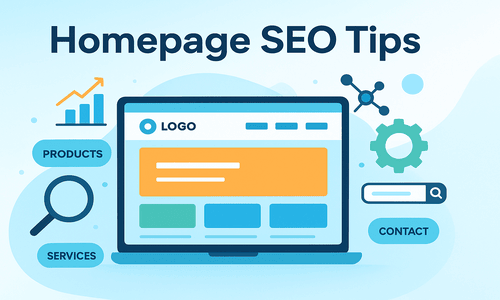Launching a new website is exciting. It’s your brand’s digital storefront — the place where many people will form their first impression of you.
But here’s the thing: even the best-looking homepage won’t make an impact if no one can find it. That’s where Homepage SEO can help you.
When you use the right SEO strategies and a user-focused design, your homepage can start ranking higher on Google and instantly grab the attention of your ideal customer.
In this guide, you will explore 13 effective homepage SEO tips to get more traffic, build trust, and turn visitors into loyal customers.
What is Homepage SEO?
Homepage SEO is about optimizing your website’s main entry page so that search engines clearly understand what your site is about. At the same time, it helps visitors recognize your brand’s services and credibility.
A well-optimized homepage also helps direct visitors to other key pages on your site, such as product listings, services, contact information, or your blog.
Unlike inner page SEO, which focuses on specific topics or keyword intent, SEO for the homepage deals with the overall theme that represents your entire business or organization.
It’s a balance between getting the technical details right and communicating your brand message clearly. You want both search crawlers and people to have a clear understanding of what your site offers.
Why does SEO Matter for your Homepage?
Your homepage is the digital front door to your business. It introduces who you are, what you stand for, and how you can help your customer. That’s why homepage SEO is so important.
Here are the key advantages it offers.
1. Builds Strong Authority
Your homepage usually gets the most backlinks from other sites. When it is well-optimized, these links help build your site’s authority in your niche. That authority, or “link equity,” can then flow to other pages. As a result, it helps rank your new website higher in search results.
2. Improves Visibility for Branded Searches
A large portion of your homepage traffic comes from branded searches. In fact, an Ahrefs study found that 45.7% of Google searches are branded. E-commerce homepage SEO ensures your business appears consistently in these search results. This is even more important if other brands share a name similar to yours. Showing up higher than these websites makes you seem more credible and trustworthy.
3. Also Targets Non-Branded Searches
According to the Zendesk Customer Experience Trends Report, 74% of customers feel loyal to a specific brand or company. A well-optimized homepage can also rank for many high-value non-branded terms. This helps you attract new visitors who may not be familiar with your brand yet but are regularly searching for similar brands like yours. It’s a smart way to expand your audience and grow organic traffic.
How to Optimize Your Homepage for SEO
Now that you know why SEO matters for your homepage, let’s help you put it into action. Here are the top 13 homepage SEO tips that can help you succeed.
1. Audit Your Homepage’s Current SEO Health
Before making any changes, take a step back and assess your current situation. A proper website audit will show you what’s working, what’s broken, and what you might be missing. Think of it as a health check for your homepage.
Here’s what you need to do:
- Verify indexing and HTTPS security of the page.
- Review Core Web Vitals for speed, stability, and responsiveness.
- Test page speed, mobile performance, and user experience.
- Keep a single canonical homepage to prevent duplicate content.
2. Analyze Competitors and Search Landscape
After understanding the SEO health of your homepage, it’s time to design your optimization strategies. The best place to start is to study your competitors. This will help you recognize what is working in your niche and identify marketing gaps that you can capitalize on.
Start by checking the SERP results using your target keyword. Check what your competitors are doing and what you can do better.
Homepage SEO best practices when researching your competitors include:
- Examine the top 10 ranking homepages in your niche.
- Note their keyword targeting, design, content length, and layout.
- Identify gaps in their content, structure, or the use of schema markup that you can improve on.
3. Create a Strong Keyword Strategy
The goal of Keywords is to tell Google and visitors what your page is about. These are usually related to your core service or product.
After analyzing your competitors, you will have some idea about the phrases that repeatedly appear in their Homepage content. You can adopt or refine these. Otherwise, brainstorm your own based on how your target audience searches.
Your keyword strategy should include:
- Primary Keyword: Select a single keyword that best represents your business or core service. Match it with the primary intent of your target audience. This could be informational, navigational, or commercial.
- Supporting Keywords: Include synonyms, brand name, and location-based phrases where relevant.
- Place Keywords Strategically: Include the keywords naturally throughout the homepage content. Avoid forced phrasing. Ideally, your primary keyword should appear in:
- H1 heading
- Title tag and meta description
- First paragraph or hero section
- Image alt text
As for secondary keywords, you should scatter them naturally throughout the page. This will include both subheadings and body content.
4. Create Compelling Meta Tags
The next step is to create keyword-optimized meta tags. These will include a meta title and a short description of your homepage. These are the first things users see about your website in their search results, so make them count:
- Title Tag: Under 60 characters. Include your main keyword along with your brand name.
- Meta Description: Within 160 characters or fewer. Highlight what makes you valuable or trustworthy. Give users a reason to click. Have a look at this simple yet impactful example.

5. Design a Clear Above-the-Fold Section
Your above-the-fold area is the first thing people see before scrolling. Use a catchy SEO homepage title that clearly conveys your main service and includes your main keyword. Then follow it up with a short and persuasive subtext that explains your value proposition.
End with a clear call-to-action, like “Get Started” or “Book a Consultation.” Make it obvious what you want visitors to do next. You can understand it visually with the following example of the Ahrefs homepage:

6. Create SEO-Friendly Homepage Content
On your homepage, “content” means every word, heading, and message that communicates your brand’s purpose and value. SEO-friendly content not only helps your site rank for your target keywords, but also communicates what your brand stands for and how it can serve its customers.
Some tips to incorporate SEO in homepage content include:
- Create clear, compelling, and scannable copy
- Use headings logically throughout the content.
- Incorporate your main and secondary keywords.
- Focus on the user’s pain points and your brand’s value
- Include FAQs to address common questions and target long-tail keywords
- Use schema markup to optimize for rich results or featured snippets.
7. Use Clear Calls-to-Action
Call-to-action buttons are the tool to bridge the gap between the traffic you get and the conversions they deliver. They guide users toward the next step – whether it’s signing up, contacting you, or making a purchase. A well-placed CTA will not only drive meaningful results for your business. It will also help engage people and reduce bounce rates.
Some best practices to use homepage CTAs include:
- Use strong, benefit-focused CTAs. Clearly show what users will gain by clicking.
- Place them strategically. Keep one above the fold and repeat naturally after key sections to keep the users engaged.
- Ensure visual contrast. Use bold colors, large buttons, and clear fonts that stand out.
- Align with your brand message. Consistent messaging builds trust and value.
- Avoid clutter. Each section should guide users toward one clear action.
8. Include Reviews and Testimonials
Reviews and testimonials from happy customers indicate that your brand is credible. They also give new visitors a reason to believe in your business’s offerings. A survey by BrightLocal reveals that 69% of customers have a positive impression of a business after reading positive reviews.
On top of that, these reviews demonstrate your expertise and authority, which directly supports Google’s E-E-A-T standards and can help lift your conversion rates.
When showcasing social proof:
- Add ‘Reviews’ Schema so Google can pick up your ratings and display them right in search results
- Include short case study snippets with links to full success stories or project pages.
- Display client logos or industry certifications to demonstrate your professionalism.
- Place testimonials near your CTAs, where users are making key decisions — it’s a great way to give them that final nudge.
- Keep your reviews fresh and updated so your homepage always feels current and trustworthy.
- Use photos or short videos. Authenticity goes a long way in making your social proof feel genuine.
The video testimonials on the PNC Logos homepage showcase a great example.

9. Strengthen Internal Linking
Internal linking is an important component in modern SEO. Use your homepage to connect visitors (and search engines) to your key internal pages. These can include Services, Product Categories, or your brand’s About page.
You can also direct SEO internal links to the homepage from your blogs, particularly with a call to action. When linking, use descriptive, keyword-rich anchor text so it’s clear what each link leads to. This improves navigation and helps distribute SEO authority throughout your site.
10. Acquire Quality Backlinks
Backlinks are links from other websites pointing to your homepage. These signal to Google that your business is trustworthy and helpful for those linking to your website. As a result, high-quality backlinks strengthen your site’s authority and improve your rankings. In fact, a study by Backlinko found that, among the top 10 search results, the number 1 ranking page has, on average, 3.8 times more backlinks than others.
When acquiring backlinks, consider these strategies:
- Focus on relevance and authority, not just the number of backlinks.
- Collaborate with industry blogs for guest posts or expert features.
- List your business in reputable directories and local listings.
- Build partnerships with organizations relevant to your business.
- Use natural, keyword-relevant anchor text for contextual linking.
- Create shareable resources like infographics or reports that others can reference.
11. Optimize Loading Speed
Google considers page loading speed a key factor in ranking. In fact, a study by Portent shows that a loading speed of 1 second has a conversion rate 3 times higher than that of 5 seconds. Therefore, optimizing speed is a non-negotiable element when it comes to getting more traffic and sales for your business.
Some helpful tips to optimize speed include:
- Compress images and minimize CSS or JS files.
- Use caching and a CDN to ensure faster load times.
- Get rid of heavy sliders or unused scripts.
- Utilize a fully responsive design that adapts to mobile devices.
12. Simplify Navigation
User experience is another SEO factor that can make or break your page’s rankings. Since your homepage is like a front gate to your website, it should help visitors easily find other pages on your site. This not only improves their navigation but also directs them to other high-converting pages.
Here’s how you can improve navigation from the homepage:
- Limit your top navigation menu to 5-7 Key Items.
- Use Sticky Headers for Easy Navigation.
- Avoid using JavaScript-heavy menus that can block crawling bots.
- Replace vague labels like ‘Solutions’ with clear ones like ‘Our Services’ or ‘Pricing’.
- For larger sites, include a search function to help users locate content faster.
13. Monitor Performance Continuously
SEO isn’t a one-time strategy. You need to regularly monitor your performance to know if your optimization efforts are really paying off. Test different versions of your page to see which one drives more engagement and conversions.
But how do you perform a homepage SEO check? Here are some tips:
- Use tools like Search Console and Analytics to track which search terms bring users to your homepage.
- Study metrics to understand how visitors interact with your homepage and where drop-offs occur.
- Use A/B testing tools to find which design or copy versions drive the best results.
- Adjust your messaging, design, or CTA to match user behavior better.
- SEO-test the homepage and user experience every few months to keep your content and technical health up to date.
Final Words
Good homepage SEO is all about balance — the right keywords, on-page SEO, and a healthy technical setup. Each element works together to attract people to your site and turn them into customers. As a business with a new website, getting your homepage just right can feel overwhelming.
At PNC Logos, we love helping brands like yours! Our strategies are designed to boost both your homepage and overall online visibility. If you’re ready to elevate your site to an authoritative online brand, get in touch with us today!





